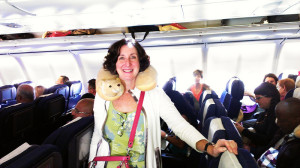-by Erin
8 Tips for Busy Travelers
Many frequent and hardcore travelers are extremely busy people. One type of traveler crams business and pleasure trips into single junkets. Another type corrals an entire family through an itinerary that would kill a hardy donkey, let alone an exhausted working parent. Another type micromanages their trip down to the minute such that they’re setting alarms at all times of day to keep themselves on schedule. And then there are those who are so busy they can barely find enough time to take their vacations, much less do all the nuts-and-bolts tasks of planning those vacations.
Below, you will find eight tips to make your trips more efficient and to meet the ultimate goal of any busy traveler: to get you there on time and with minimal hassle.
But First: Slow Down, You Move Too Fast
Before we get started here, let’s take a step back and think about slowing down. I appreciate that to do both of those (step back and slow down) at the same time might be tough for some of us, so grab the arms of your chair and take a deep breath first.
Okay.
In some cases, folks just need to slow the heck down. It wasn’t so long ago that you’d take a boat to Europe. Travelers in less hyper-developed countries will continue to experience maddening slowdowns and complete shutdowns; in the nation of the all-night CVS and the 24-hour ATM, some folks are shocked to hear “I’m sorry, sir, we’re closed.”
Time isn’t always going to bend to your will; for your own sanity, you’d better get used to it.
Okay, that’s enough deep breathing and slowing down for a weekday. Let’s put the hammer down and get back up to speed. Here come the tips:
This is the one key thing you can do to guarantee easier passage through security, tight connections, terminal shutdowns, backtracking planes, and other serious and mundane hazards of post-9/11 travel. It’s also the best way to avoid the many baggage fees that the airlines are now heaping on travelers who dare to bring more than a carry-on.
2. Dress for success at security.
Your favorite traveling clothes and accessories could cause slowdowns at airport security. Leave the jewelry at home, remove your piercings (if possible) and wear clothing that won’t hold you up in the security line — like slip-on shoes, belts with plastic buckles instead of metal, and simple clothing that doesn’t require elaborate searching.
A truly busy person has learned how to move projects around, make doctor’s appointments from the train platform, walk the dog while the coffee’s brewing. If you’re this kind of person, you’re probably only truly put out if you can’t get anything done at all. Thus, a couple of traveling items to help you cope with those all-too-frequent delays at the airport:
Program the phone numbers of your airline, car rental company, shuttle service and hotel into your cell phone. If you’ve got time to kill during a flight delay, you can make a few calls and provide your new ETA to anyone waiting for you at your destination. (For even more efficiency, check to see which other airlines also fly your itinerary and program their phone numbers in as well — that way if your original flight is delayed, you can start calling around for alternatives.)
Have a to-do list of productive things you can work on during delays. This might be a good time to read that chapter in your guidebook on the history of the place you’re visiting, or to sketch out a detailed itinerary for the first few days of your trip.
4. Use a travel agent.
Why not leave all the heavy lifting to someone else? Consider the difference between scouring countless websites for the best deal and itinerary, then making a purchase, then putting together your own travel itinerary versus placing one phone call or e-mail to your travel agent – this could add up to hours of your life on every trip.
5. Ask for seats near the front of the plane.
You’ll get on last, granting you time to get more things done before boarding lockdown, and you’ll get off first. Many airlines now allow you to select your seat online at the time of booking or check-in (sometimes for a fee) – this is the best way to guarantee yourself the seat you want.
6. Know where the airport gas station is.
If you are responsible for returning your rental car with a full tank of gas, ask where the closest gas station is before you drive off the lot. This way you won’t be driving around looking and hoping for a gas station to fill your tank just before returning.
7. Reuse your packing list.
If you’re the type of traveler that scribbles down a hasty packing list before every trip (and inevitably forgets some vital item each time), get organized by creating a single comprehensive packing list and saving it on your computer. Before each trip, customize the list as necessary and then print out a copy to refer to as you pack.
8. Use these time-tested tactics.
Fly direct. Connections cost time; missed connections cost lots of time. Avoid layovers where you can.
Fly early in the day; there are fewer delays, cancellations and people in the airport.
Consider alternate airports. They’re less crowded and often better located than the big hubs, and they have fewer flights going in and out – reducing your chances of delays.
Original source: Independent Traveler














